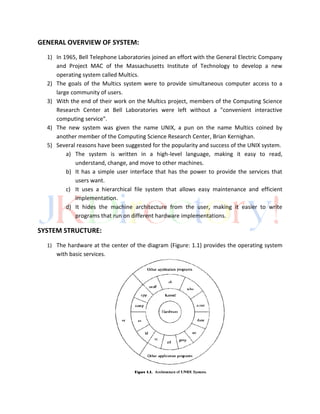
UNIX INTERNALS UNIT-I
- 1. GENERAL OVERVIEW OF SYSTEM: 1) In 1965, Bell Telephone Laboratories joined an effort with the General Electric Company and Project MAC of the Massachusetts Institute of Technology to develop a new operating system called Multics. 2) The goals of the Multics system were to provide simultaneous computer access to a large community of users. 3) With the end of their work on the Multics project, members of the Computing Science Research Center at Bell Laboratories were left without a "convenient interactive computing service". 4) The new system was given the name UNIX, a pun on the name Multics coined by another member of the Computing Science Research Center, Brian Kernighan. 5) Several reasons have been suggested for the popularity and success of the UNIX system. a) The system is written in a high-level language, making it easy to read, understand, change, and move to other machines. b) It has a simple user interface that has the power to provide the services that users want. c) It uses a hierarchical file system that allows easy maintenance and efficient implementation. d) It hides the machine architecture from the user, making it easier to write programs that run on different hardware implementations. SYSTEM STRUCTURE: 1) The hardware at the center of the diagram (Figure: 1.1) provides the operating system with basic services.
- 2. 2) The operating system interacts directly with the hardware, providing common services to programs and insulating them from hardware idiosyncrasies. 3) Viewing the system as a set of layers, the operating system is commonly called the system kernel, or just the kernel, emphasizing its isolation from user programs. 4) Programs such as the shell and editors (ed and vi) shown in the outer layers interact with the kernel by invoking a well defined set of system calls. 5) The system calls instruct the kernel to do various operations for the calling program and exchange data between the kernel and the program. USER PERSPECTIVE: It will discuss about high-level features of the UNIX system such as the file system, the processing environment, and building block primitives. The UNIX file system is characterized by, a hierarchical structure, consistent treatment of file data, the ability to create and delete files, dynamic growth of files, the protection of file data, the treatment of peripheral devices (such as terminals and tape units) as files. The file system is organized as a tree with a single root node called root (written “/”); every non-leaf node of the file system structure is a directory of files, and files at the leaf nodes of the tree are either directories, regular files, or special device files. The name of a file is given by a path name (a sequence of component names separated by slash characters). PROCESSING ENVIRONMENT: A program is an executable file, and a process is an instance of the program in execution. Many processes can execute simultaneously on UNIX systems (this feature is sometimes called multiprogramming or multitasking) with no logical limit to their number, and many instances of a program (such as copy) can exist simultaneously in the system. Various system calls allow processes to create new processes, terminate processes, synchronize stages of process execution, and control reaction to various events. Following is an example program that Creates a New Process to Copy Files: main(argc, argv) int argc; char *argv[]; { /* assume 2 args: source file and
- 3. target file */ if (fork() -- 0) execl("copy", "copy", argv[1], argv[2], 0); wait({int *) 0); printf("copy donen"); BUILDING BLOCK PRIMITIVES: The philosophy of the UNIX system is to provide operating system primitives that enable users to write small, modular programs that can be used as building blocks to build more complex programs. One such primitive visible to shell users is the capability to redirect I/O. Processes conventionally have access to three files: they read from their standard input file, write to their standard output file, and write error messages to their standard error file. For example, the command line Is lists all files in the current directory on the standard output. OPERATING SYSTEM SERVICES: More Content … click the link … below: Download
